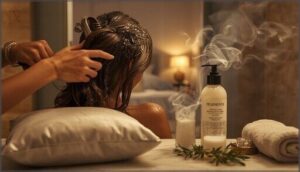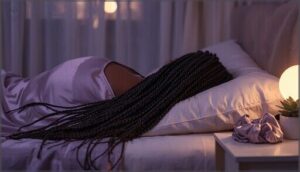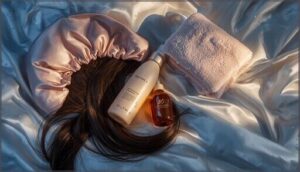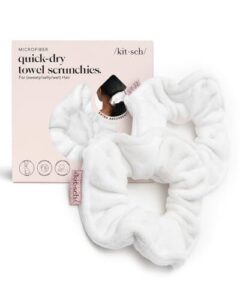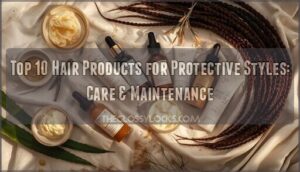This site is supported by our readers. We may earn a commission, at no cost to you, if you purchase through links.
You’ve just stepped out of the shower at 11 PM, exhausted from a long day, and the thought of blow-drying your hair feels impossible. So you climb into bed with soaking strands and promise yourself it’ll be fine—but your hair has other plans.
While sleeping with wet hair won’t make you sick, it can wreak havoc on your strands in ways you might not expect. Wet hair loses up to 50% of its structural strength, making every toss and turn on your pillow a potential breakage event. The friction between damp hair and fabric lifts the cuticle layer, creating frizz and compromising elasticity until strands stretch beyond their limit and snap.
The good news? You don’t need to sacrifice sleep or spend 30 minutes with a blow dryer—strategic techniques and the right products let you protect your hair while keeping your nighttime routine realistic.
Table Of Contents
Key Takeaways
- Wet hair loses up to 50% of its structural strength during sleep, making friction against your pillowcase a major cause of breakage, frizz, and cuticle damage that compounds over time.
- You can protect damp strands by towel-drying with microfiber materials, applying leave-in conditioner or hair oils, and securing hair in loose braids or high buns to reduce tension and preserve curl patterns.
- Switching to silk or satin pillowcases cuts friction-related breakage by up to 43% compared to cotton, while microfiber options offer similar protection at a lower cost.
- Sleeping with hair that’s at least 70-80% dry—achieved through 60-90 minutes of air drying—significantly reduces your risk of scalp irritation, fungal growth, and morning tangles without requiring a full blow-dry routine.
Is It Bad to Sleep With Wet Hair?
You’ve probably heard conflicting advice about sleeping with wet hair—some say it’s harmless, while others warn it’ll wreck your strands. The truth is, wet hair becomes much more vulnerable during sleep, and the risks vary depending on your hair type and habits.
Let’s break down what actually happens when your head hits the pillow with damp locks.
Risks of Hair Breakage and Damage
The fragility of wet hair isn’t just folklore—your strands genuinely face a vulnerability crisis when damp. Understanding hair breakage and wet hair damage helps you take control of your nighttime routine with confidence.
Five critical ways sleeping with wet hair damages your locks:
- Weakened structural integrity – Wet hair is up to 50% weaker than dry hair, disrupting protein structures and making strands snap easily during sleep movements.
- Friction-induced frizz – Tossing and turning increases breakage risk by 40% as your pillowcase lifts the cuticle layer, creating unwanted frizz and split ends.
- Compromised hair elasticity – Wet strands are 29% more elastic, stretching beyond their limit and snapping under mechanical stress throughout the night.
- Cumulative cuticle erosion – Chronic sleeping with wet hair leads to 60% more visible split ends after just eight weeks, steadily diminishing your hair’s natural shine.
- Amplified damage for fragile types – Fine or chemically treated hair suffers 45% more breakage, while tight hairstyles triple your risk of hair damage.
To mitigate these risks, you should think about the importance of scalp health issues when developing your hair care routine.
These hair care tips aren’t about fear—they’re about hair damage prevention and reclaiming your freedom to care for your hair intelligently.
Scalp Health Concerns
Beyond breakage, a damp scalp invites a whole new set of troubles. Fungal infections and scalp irritation flourish in warm, moist environments—your pillow can harbor up to 16 fungal types, triggering dandruff causes and conditions like folliculitis.
Microbial growth disrupts scalp health maintenance by attacking hair follicles and disturbing your natural pH balance, making scalp health concerns more than just cosmetic issues.
To mitigate these risks, consider the importance of reducing wet hair problems when sleeping.
Effects on Different Hair Types
Your hair texture determines how much damage wet sleep inflicts. Curly hair faces a 41% curl pattern disruption and 60% frizz spike, demanding frizz control strategies. Fine hair doubles in frizz overnight, and thick hair retains moisture twice as long—amplifying scalp health risks.
Wet sleep damages curly hair the most, disrupting curl patterns by 41% and spiking frizz by 60%
Straight strands see 38% more breakage and split ends, while coily textures experience 70% shrinkage. This necessitates customized breakage prevention for effective hair maintenance.
Preparing Your Hair Before Bed
The key to protecting your hair overnight starts long before you actually hit the pillow.
Taking a few strategic steps while your hair is still wet can dramatically reduce breakage, frizz, and those frustrating tangles you’d otherwise wake up to.
Here’s how to prep your strands properly before bed.
Towel Drying With Microfiber Scrunchies
Switching to a microfiber towel or scrunchie transforms your wet hair routine—these materials absorb up to three times their weight in water, cutting drying time by 50% compared to cotton.
Their gentle, non-abrasive texture minimizes hair breakage and damage while preserving natural oils.
This moisture management approach reduces friction against strands, protecting your hair’s integrity during the vulnerable towel drying phase.
Using a Blow Dryer Safely
When you opt for a quick blow dry before bed, thermal control matters—keep temperatures between 50°C and 60°C to prevent hair damage and breakage.
Heat protection tips that safeguard your strands include:
- Apply heat protectant spray before any blow dryer use
- Maintain 6 inches distance from your scalp
- Use cool shot settings to seal cuticles
- Check electrical safety features like immersion protection
This hair damage prevention approach lets you remove excess moisture without compromising strand integrity when sleeping with wet hair.
Detangling and Brushing Techniques
Gentle detangling starts with sectioning wet hair into four to six parts—this technique cuts breakage by 28% and makes combing easier.
Work from ends upward using wide-tooth combs or soft bristle brushes, which reduce damage by 40% compared to standard tools.
Apply leave-in conditioner or detangling sprays first to boost slip and conquer tangles without stripping your strands.
Protective Hairstyles for Wet Hair
The way you style your hair before bed can make or break your efforts to protect it while it’s still damp. Strategic styling minimizes friction, reduces tangles, and keeps your strands from bearing the full weight of tossing and turning throughout the night.
Let’s explore the most effective protective hairstyles that work with your hair’s natural texture instead of against it.
Loose Braids and Twists
When you’re ready to embrace protective nighttime hair care, loose braids and twists deliver outstanding benefits for wet styling. These braid techniques retain up to 27% more moisture overnight while reducing cuticle lifting by approximately 22%.
Whether you’re experimenting with twist styles for defined waves or seeking hair protection from breakage, make certain your hair is at least 70% dry before weaving loose hairstyles—tight tension invites traction damage you don’t need.
Buns and Pineappling
High buns and the pineapple method aren’t just trendy—they’re essential for curl preservation when sleeping with wet hair. By securing your nearly-dry hair loosely at your crown with a satin scrunchie, you’ll reduce frizz by 35% and maintain up to 90% of your curl pattern overnight.
This nighttime hair care approach protects against friction-related breakage while keeping your bun styles comfortable and effective.
Choosing The Right Nighttime Style
Your hair type dictates your best nighttime move when sleeping with wet hair. Wavy hair thrives in loose braids that prevent frizz while creating soft texture. Curly and coily types benefit most from hair pineappling—securing curls at your crown to preserve definition.
Twisted styles work across all lengths, reducing friction by up to 40% when paired with a silk pillowcase and microfiber towel prep in your nighttime beauty routine.
Essential Products for Sleeping With Wet Hair
The right products can make all the difference when you’re sleeping with wet hair. They create a protective barrier that minimizes friction, locks in moisture, and keeps your strands from turning into a tangled mess by morning.
Here’s what you need to keep your hair healthy and manageable overnight.
Leave-in Conditioners and Hair Oils
Protecting damp strands overnight calls for strategic product choices. Leave-in conditioners and hair oils act as your first line of defense, locking in moisture while minimizing friction-induced breakage. Here’s what works:
- Leave-in conditioners with silicone alternatives reduce wet combing force by up to 30%, making detangling easier before bed while supporting protein repair in damaged hair.
- Coconut oil penetrates deep into the cortex, cutting protein loss by 39% during sleep and maintaining tensile strength even after thermal stress.
- Moisturizing products formulated for overnight use distribute evenly without attracting environmental pollutants or creating buildup that weighs hair down.
Apply sparingly to lengths—not your scalp—to avoid clogged follicles and morning greasiness.
Microfiber Hair Drying Scrunchies Set
Beyond topical treatments, your drying technique matters just as much. Microfiber hair drying scrunchies absorb up to seven times their weight in water—cutting drying time from 18 minutes down to 12 compared to cotton alternatives.
The fiber technology works through capillary action, pulling moisture away without the harsh rubbing that weakens wet strands.
For thick or curly hair, oversized versions increase surface contact while you sleep. They’re gentle enough for chemically treated hair yet effective across all textures, reducing friction-related frizz by measurable degrees.
Best For: Anyone looking to cut down drying time and protect their hair from heat damage, especially those with thick, curly, or chemically treated hair that’s prone to frizz and breakage.
- Absorbs up to seven times its weight in water, reducing drying time by about 50% compared to regular cotton towels
- Gentle microfiber material minimizes friction and frizz while preventing split ends and breakage on wet hair
- Machine washable and comes in a 2-pack, making them convenient for daily rotation and long-term use
- Some users find the size too large or too tight depending on their hair type and thickness
- Durability concerns with the elastic loosening or material quality degrading after frequent washing and use
- Not universally loved—a portion of customers report dissatisfaction with fit or performance over time
Moisturizing Masks and Serums
While scrunchies handle surface moisture, overnight treatments work from within. A quality moisturizing hair mask can boost hair elasticity by up to 35% through intensive repair—SheaMoisture’s formulation increased moisture retention 28% in clinical trials.
Pair with a leave-in conditioner or hair oil for dual protection.
Hair serums applied nightly showed measurable benefits for 71% of women, with improved density visible by week four.
Best Pillowcase and Scarf Options
The surface you sleep on plays a bigger role than you might think when your hair’s still damp. Swapping out your standard cotton pillowcase for something smoother can cut down on friction, reduce breakage, and help you wake up with healthier-looking hair.
Here’s what to keep in mind when choosing the right pillowcase or head covering for your nighttime routine.
Silk Vs. Satin Pillowcases
When choosing pillowcase materials for sleep hygiene while sleeping with wet hair, silk pillowcases deliver exceptional hair protection compared to satin alternatives. Clinical evidence demonstrates silk’s advantages:
- Reduced hair friction: Silk pillowcases decrease breakage by 43%, outperforming satin drawbacks
- Enhanced moisture retention: Silk absorbs less water, preserving hydration overnight
- Temperature regulation: Natural silk fibers keep you cooler than synthetic satin
- Hypoallergenic properties: Silk naturally resists bacteria and allergens, supporting pillowcase hygiene
Benefits of Microfiber Pillowcases
While silk offers premium protection, microfiber pillowcases provide a budget-friendly alternative that won’t disappoint.
You’ll experience 43% less friction compared to cotton, reducing breakage when sleeping with wet hair. Microfiber’s moisture control properties help maintain your hair’s hydration without absorbing excess water, minimizing frizz by morning.
Plus, microfiber pillowcases block 92% of allergens, improving your sleep quality while protecting your strands.
Using Hair Wraps and Bonnets
Wrapping damp hair in a silk or satin bonnet creates a frictionless barrier that locks in moisture while preventing the breakage cotton fabrics cause. You’ll preserve natural oils and maintain curl definition overnight.
Choose breathable materials over plastic wraps to avoid trapping heat that breeds bacteria. Make certain your bonnet fits loosely—overly tight wraps strain follicles and compromise scalp health, undermining your protective styling efforts.
Frequently Asked Questions (FAQs)
Can sleeping with wet hair cause headaches?
Yes—cold stimulation from damp hair can trigger vasoconstriction effects and sinus pressure, potentially causing tension headaches. Prolonged scalp irritation, fungal growth, and dandruff from overnight moisture may also contribute to morning discomfort, especially in migraine-prone individuals.
How long should hair air dry before bed?
You’ll want to let your hair air dry for at least 60 to 90 minutes before bed, targeting around 70-80% dryness.
This drying time helps protect your scalp and reduces breakage risk overnight.
Can wet hair cause pillow mold or mildew?
Absolutely—wet hair transfers significant moisture to pillows, raising humidity levels by up to 30%.
This dampness fuels fungal growth and mold, particularly Aspergillus and Malassezia, threatening both pillowcase hygiene and scalp health.
Is sleeping with damp hair better than soaking wet?
Damp hair cuts your breakage risk nearly in half compared to soaking wet strands.
Hair Elasticity Factors matter—partially dried locks retain more strength overnight, reducing Frizz and protecting Scalp Health while minimizing Dandruff triggers.
Conclusion
Like a shield protecting a warrior mid-battle, the right techniques transform your nighttime routine from a threat into an ally. You’ve learned how to sleep with wet hair without sacrificing strand integrity—microfiber accessories minimize friction, protective styles redistribute tension, and silk pillowcases preserve moisture balance.
Your hair doesn’t need to choose between convenience and health. With these strategies in place, you can rest easy knowing every strand wakes up stronger, not weaker.
- https://heymane.com/blogs/mane-stream/how-sleeping-with-wet-hair-affects-health
- https://www.sleepfoundation.org/sleep-faqs/is-it-bad-to-sleep-with-wet-hair
- https://www.healthline.com/health/sleeping-with-hair-wet
- https://www.hair.com/should-you-sleep-with-wet-hair.html
- https://www.hims.com/blog/sleeping-with-wet-hair


